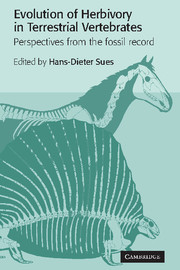Book contents
- Frontmatter
- Contents
- List of contributors
- Preface
- 1 Herbivory in terrestrial vertebrates: an introduction
- 2 Herbivory in late Paleozoic and Triassic terrestrial vertebrates
- 3 Prosauropod dinosaurs and iguanas: speculations on the diets of extinct reptiles
- 4 The evolution of sauropod feeding mechanisms
- 5 Plant-eaters and ghost lineages: dinosaurian herbivory revisited
- 6 Dental constraints in the early evolution of mammalian herbivory
- 7 Patterns in the evolution of herbivory in large terrestrial mammals: the Paleogene of North America
- 8 Origin and evolution of the grazing guild in Cenozoic New World terrestrial mammals
- Taxonomic index
- Subject index
8 - Origin and evolution of the grazing guild in Cenozoic New World terrestrial mammals
Published online by Cambridge University Press: 22 October 2009
- Frontmatter
- Contents
- List of contributors
- Preface
- 1 Herbivory in terrestrial vertebrates: an introduction
- 2 Herbivory in late Paleozoic and Triassic terrestrial vertebrates
- 3 Prosauropod dinosaurs and iguanas: speculations on the diets of extinct reptiles
- 4 The evolution of sauropod feeding mechanisms
- 5 Plant-eaters and ghost lineages: dinosaurian herbivory revisited
- 6 Dental constraints in the early evolution of mammalian herbivory
- 7 Patterns in the evolution of herbivory in large terrestrial mammals: the Paleogene of North America
- 8 Origin and evolution of the grazing guild in Cenozoic New World terrestrial mammals
- Taxonomic index
- Subject index
Summary
Introduction
Today grasslands cover about 25% of the world's land surface and constitute an enormous food resource that is exploited by invertebrate and vertebrate grazers. Grazers are defined as herbivores with diets consisting predominantly (>90%) of grass and other associated low ground cover in grassland biomes (Janis and Ehrhardt 1988). In present-day ecosystems, grazing is a common-place feeding strategy. Although terrestrial herbivory can be documented in vertebrates over the past 300 million years since the Carboniferous (Sues and Reisz 1998; Reisz and Sues, this volume), the origin of the grazing guild in vertebrates is a relatively recent arrival on the global ecological landscape.
This chapter presents paleontological evidence that terrestrial grazing guilds have only existed since the middle Tertiary, about 35 million years ago. I will confine my discussion here to mammals because: (1) although in terms of biomass and diversity, invertebrate grazers (mostly insects) are potentially the largest component of terrestrial grazing guilds worldwide (Dyer et al. 1982), the fossil record of this group is relatively poor; and (2) extinct mammalian grazers generally have an exceedingly rich fossil record that can be used to understand the evolution of the grazing guild. Furthermore, recent studies of extinct mammalian grazers combine a diverse array of traditional morphological evidence along with some new techniques, including stable isotopic analyses. Together these techniques allow a better understanding of the origin and evolution of the grazing guild. This chapter will focus attention on the fossil record in the New World; however, the pattern described here also is generally applicable to the Old World.
- Type
- Chapter
- Information
- Evolution of Herbivory in Terrestrial VertebratesPerspectives from the Fossil Record, pp. 223 - 244Publisher: Cambridge University PressPrint publication year: 2000
- 19
- Cited by



